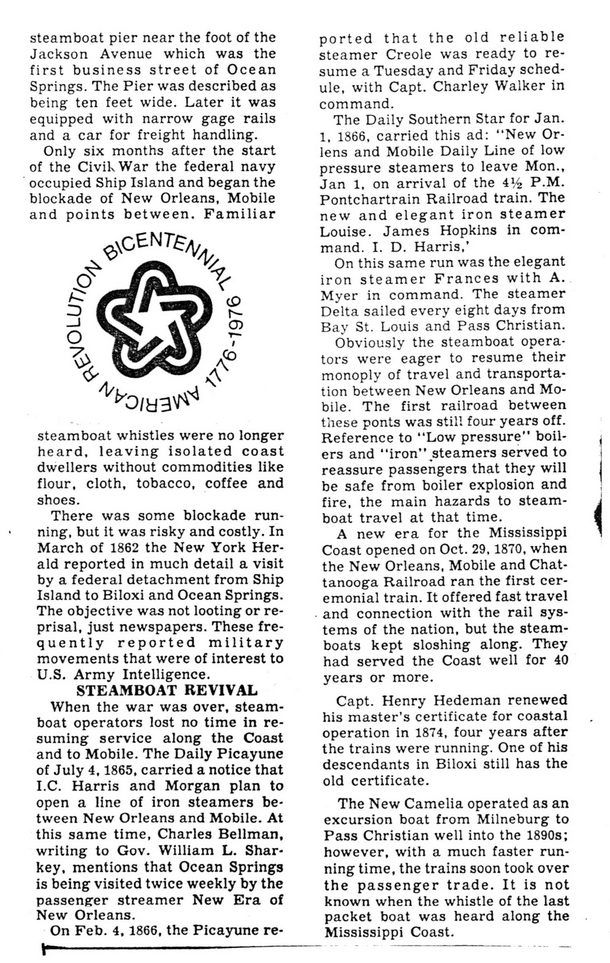This text was obtained via automated optical character recognition.
It has not been edited and may therefore contain several errors.
steamboat pier near the foot of the Jackson Avenue which was the first business street of Ocean Springs. The Pier was described as being ten feet wide. Later it was equipped with narrow gage rails and a car for freight handling. Only six months after the start of the CivikWar the federal navy occupied Ship Island and began the blockade of New Orleans, Mobile and points between. Familiar «eEN7^. ^0/y3V^ steamboat whistles were no longer heard, leaving isolated coast dwellers without commodities like flour, cloth, tobacco, coffee and shoes. There was some blockade running, but it was risky and costly. In March of 1862 the New York Herald reported in much detail a visit by a federal detachment from Ship Island to Biloxi and Ocean Springs. The objective was not looting or reprisal, just newspapers. These fre-quently reported military movements that were of interest to U.S. Army Intelligence. STEAMBOAT REVIVAL When the war was over, steamboat operators lost no time in resuming service along the Coast and to Mobile. The Daily Picayune of July 4,1865, carried a notice that I.C. Harris and Morgan plan to open a line of iron steamers between New Orleans and Mobile. At this same time, Charles Bellman, writing to Gov. William L. Sharkey, mentions that Ocean Springs is being visited twice weekly by the passenger streamer New Era of New Orleans. On Feb. 4, 1866, the Picayune re- \r------------------------------ ported that the old reliable steamer Creole was ready to resume a Tuesday and Friday schedule, with Capt. Charley Walker in command. The Daily Southern Star for Jan. 1, 1866, carried this ad: “New Or-lens and Mobile Daily Line of low pressure steamers to leave Mon., Jan 1. on arrival of the 4'^ P.M. Pontchartrain Railroad train. The new and elegant iron steamer Louise. James Hopkins in command. I. D. Harris,’ On this same run was the elegant iron steamer Frances with A. Myer in command. The steamer Delta sailed every eight days from Bay St. Louis and Pass Christian. Obviously the steamboat operators were eager to resume their monoply of travel and transportation between New Orleans and Mobile. The first railroad between these ponts was still four years off. Reference to ‘‘Low pressure" boilers and "iron” steamers served to reassure passengers that they will be safe from boiler explosion and fire, the main hazards to steamboat travel at that time. A new era for the Mississippi Coast opened on Oct. 29,1870, when the New Orleans, Mobile and Chattanooga Railroad ran the first ceremonial train. It offered fast travel and connection with the rail systems of the nation, but the steamboats kept sloshing along. They had served the Coast well for 40 years or more. Capt. Henry Hedeman renewed his master’s certificate for coastal operation in 1874, four years after the trains were running. One of his descendants in Biloxi still has the old certificate. The New Camelia operated as an excursion boat from Milneburg to Pass Christian well into the 1890s; however, with a much faster running time, the trains soon took over the passenger trade. It is not known when the whistle of the last packet boat was heard along the Mississippi Coast.

Boats Gulf-Coast-Edition-1975-Steamboats-(3)